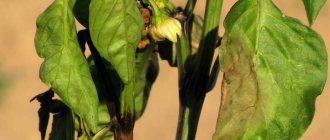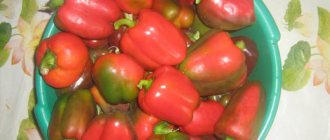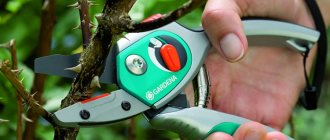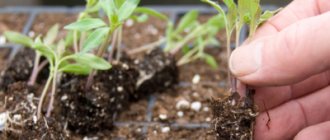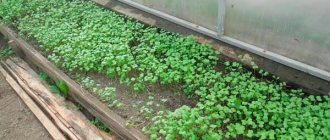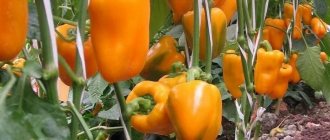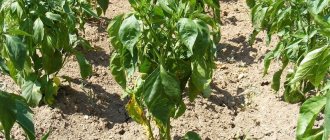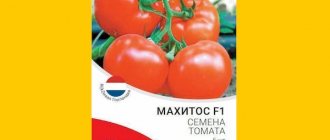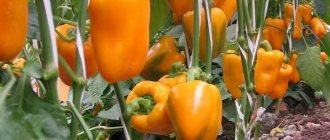Many gardeners who do not have sufficient experience try to understand the techniques of forming a bush. In particular, the question of whether it is necessary to pick off the lower leaves of peppers in order to increase the size of the fruits and promote their faster ripening still remains controversial.
This method is great for other vegetables, for example tomatoes, and is therefore intensively used by some gardeners for different varieties of peppers, but many consider it a simple waste of time. Next, we will consider in what cases it is necessary to pluck shoots from peppers, and when this should not be done.
Is it necessary to pick off the leaves of peppers in a greenhouse?
Vegetables that are traditionally grown in a greenhouse - tomatoes and cucumbers - are usually pinched, that is, some of their leaves are cut off to increase the yield. But is this method suitable for peppers?
Initially, pepper seedlings develop into one stem, but after that it branches. Many stepsons are formed in the internodes. Trimming leaves, pinching empty shoots and excess buds allows you to properly form the bush.
It is believed that pruning helps peppers grow larger fruits and improves the quality of the harvest. They make it so that there are more peppers and they ripen earlier.
Points for and against
Strong arguments for:
- Peppers are light-loving plants. With an excess of green mass, they suffer from a lack of lighting. Bushes with a thinned crown are illuminated more evenly and efficiently.
- The greenhouse has a humid microclimate, so it is desirable that the plants are well ventilated. This is important for the prevention of diseases caused by high humidity, especially with dense plantings.
- After removing excess leaves, it is easier to care for the peppers: water, fertilize, loosen the soil between plantings.
- Proper formation of the bush improves the taste of the fruits and helps increase their quantity.
Arguments against:
- Pepper is sensitive to pruning of leaves and shoots. The growth of the bush slows down.
- If excess leaves are removed too early or when the plant is sick, it will stop developing or even die.
- Due to the removal of stems important for fruiting, the risk of getting a meager harvest will increase.
- Some gardeners think that a bare bush does not look aesthetically pleasing.
The solution to this issue depends on the type of pepper, the time you are willing to devote to caring for it, and the amount of the expected harvest.
How to properly remove leaves
To avoid harming your peppers, follow these simple instructions:
- When the ovaries of the peppers are formed and the fruits on the lower branches have already begun to reach technical ripeness, remove all the leaves on the main stem from the ground to the first fork.
- When the fruit on the fork above has ripened, remove all the leaves underneath it and trim off branches that have already been harvested.
Necessary tool
Have garden shears or hand pruners ready. Be sure to disinfect them to avoid infection. Some gardeners do not trim the leaves, but break them off by hand.
Different methods
You can remove leaves in different ways:
- In tall varieties, additionally pinch off all the side shoots on each fork after the first bud. But one sheet is always left. With proper care, an adult bush will reach 1-1.5 m in height and will be evenly covered with fruits.
- In medium-sized varieties, only the crown bud and lower leaves up to the fork are cut off.
- Dwarf varieties require slight leaf thinning to keep the fruit open and aerated. If your goal is to get a small but early harvest, save the crown flower and the first buds.
Each method is correct depending on the type of pepper. If in doubt, check the instructions on the back of the seed packet.
Value for different varieties
There are many different varieties of peppers, differing in the size of the bushes. And if low-growing varieties do not have too lush green mass, then tall ones can reach a height of 2 m and have dense foliage.
The need for plant formation is determined depending on its height:
- low-growing varieties with a height of up to 50 cm can be grown without formation, provided that they are not planted too close to each other. If the plants are planted densely enough, then you need to trim off excess shoots and leaves to improve air access to the roots and provide lighting to all ripening fruits;
- Medium-sized varieties of pepper grow to a height of about 1 m and require pruning of the lower barren shoots, which needlessly draw juices from the plant. It is also recommended to get rid of some leaves so that the thick green crown does not shade the fruit from the light;
- tall varieties of bell pepper grow up to 2 m and require mandatory shaping. They need to be grown in 1–3 stems, promptly removing stepsons, excess shoots and leaves, as well as stopping the growth of the main branches at the stage of ripening of the formed fruits.
Tall varieties of peppers cannot be grown without forming the crown of the bush and tying up each branch. Medium-sized varieties can be satisfied by removing the lower shoots and barren branches.
This saves the plant from the unproductive costs of maintaining them, and also improves the illumination and ventilation of all elements of the bush.
If the variety is undersized, and especially dwarf, then it is not worth cultivating it at all. Unless the seedlings are planted too densely. This entails an increased density of tops, fraught with plant diseases and a slowdown in their development. In this case, willy-nilly, you will have to start forming the crown of the bushes, otherwise things will not go well with the harvest.
Is it necessary to cut off the stepsons
Stepchildren actively grow from all forks and take away the strength of the shoots on which the main crop is formed. To prevent thickening, they are removed.
Advice. Shape the peppers, keeping 2-3 stems. Trim excess shoots above the first leaf in each new branch, leaving 1-2 of the strongest branches. Do not touch the first leaf of the subsequent fork. It will nourish the ovary.
First buds
When planted in a greenhouse, pepper seedlings grown in pots already have their first buds. Young peppers, until this time limited to the space of the pot, have poorly developed roots. After transplanting to a permanent location, active growth of root and leaf mass will begin. In order not to interfere with this process, the first buds are removed.
The earliest bud on a pepper appears at the bottom fork, above the first leaf. It is called the crown flower and is usually recommended to be removed immediately after planting the bush.
If you did not have time to do this at the flowering stage, cut off the already developing lowest fruit. Growing at the very base, it will draw out all the juices of the bush. As a result, the pepper will grow only this fruit, and those higher up will not ripen, will become smaller or fall off.
When the pepper begins to rapidly develop and bloom, many buds form on it. Some of them are barren flowers, so they must be plucked out. If this is not done, the plant will not have enough strength to fully develop all the ovaries. The fruits will be small, hard, with thin walls, and they will take longer to ripen.
Advice. Calculate the number of leaves required for full development using the formula: 2 leaves = 1 fruit. To get a harvest of juicy, tasty peppers, leave 12-15 buds per bush, and mercilessly remove the rest.
When should you not pick off the leaves of peppers?
The procedure of tearing off leaves in some cases is harmful:
- When plants are planted very rarely or one at a time. Without the lower leaves they will suffer from lack of shade. As a result, the moisture will quickly evaporate, and the soil at the roots will dry out. This will reduce the yield.
- When plants are weakened. The formation of a bush is indicated only for healthy peppers, which will easily tolerate this procedure.
It is not recommended to cut off, but you still have to do it when:
- the lower leaves lie on the ground;
- they turned yellow;
- when planted in open ground, some of the leaves ended up below the level of the hole.
Planting seedlings
Planting pepper seedlings in open ground begins in warm weather.
It is advisable to plant seedlings at a favorable time, excluding frosts and low temperatures. Since pepper is a heat-loving and light-loving vegetable plant. It is used as a food product for fresh consumption or as a component for canning. This plant can vary in color:
- yellow;
- red;
- green;
- orange.
The form could be as follows:
- cone-shaped;
- ovoid;
- pyramidal;
- tomato-shaped;
- cherry-shaped.
After planting, be sure to water thoroughly; this will help the seedlings acclimatize faster. After strengthening the seedlings in the soil and developing several shoots, they come to a decision about whether to plant the peppers. Stepping has several advantages:
- Removing several shoots allows the rest to develop to their full potential.
- Guarantee of large and fragrant fruits.
- Providing more sun is achieved by removing excess shoots.
Advice from experienced summer residents
Experienced gardeners have different points of view. Someone advises to remove leaves and considers this procedure extremely important. For some, on the contrary, it is a waste of time.
We have selected tips that will help you get a guaranteed good harvest of peppers:
- Pick off the leaves at the stage of ripening of the first fruits. Do this gradually, two leaves at a time, starting from the lowest branch. When the harvest from the lower branches is harvested, begin to tear off the leaf blades located above, and cut off the lower branches.
- The optimal planting density of peppers in a greenhouse is up to 8 pieces per 1 m².
- Dwarf and low-growing varieties do not need pruning, but for ventilation, fruitless branches and lower leaves are cut off.
- At the end of August, remove the tops of the peppers along with all the leaves and new buds. At this time, the formation of new ovaries is no longer relevant, they will not have time to ripen, so get rid of all growth points. The bushes must give all their strength to ripen the previously formed fruits.
Aftercare
In order for the farmer to have a good harvest of sweet peppers at the end of the season, in addition to proper formation, the bushes need to be provided with the necessary care.
The basic rules for caring for peppers in a greenhouse are listed below:
- watering as needed, but at least once every 5–7 days. Water for irrigation should be warm, about 2 liters are consumed per plant;
- ventilation of the greenhouse to reduce humidity levels and prevent condensation;
- feeding plants with mineral fertilizer complexes after transplanting seedlings, before flowering and at the stage of fruit formation;
- loosening the top layer of soil around the bushes to improve air permeability;
- protecting plants from direct sunlight in hot weather (above 30°C);
- tying side shoots to installed supports to balance the plants.
Important! In hot weather, pepper bushes need to be watered at least 2 times a week.
Why pick leaves from peppers?
To remove or not to remove pepper leaves? This question usually begins to worry gardeners when peppers are actively growing green mass. Many are afraid that the plants will become “fat” and become reluctant to bloom and set fruit. And removing the leaves, at first glance, seems to be an ideal way to switch the “attention” of peppers to abundant fruiting.
But in reality everything is not so simple. Removing a large number of leaves may not only bring no benefit, but even worsen the condition of the bush.
On the Internet you can meet many lovers of “half-bald” bushes who talk about gigantic harvests. But I don’t believe all this and prefer to rely on my own experience. Besides, I think that bushes should look beautiful, but “shabby” plants have a depressing effect on me
